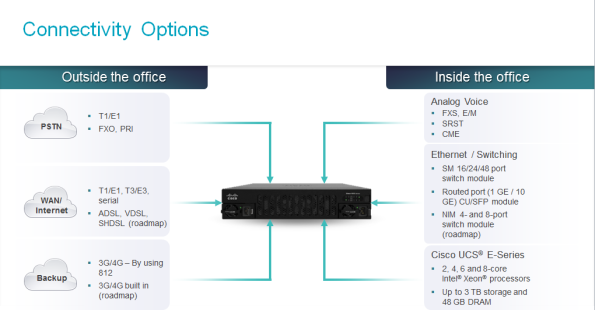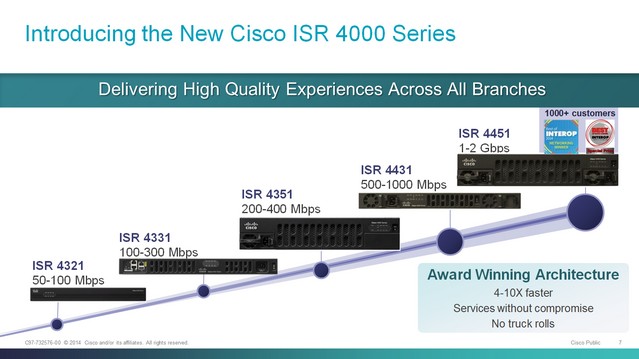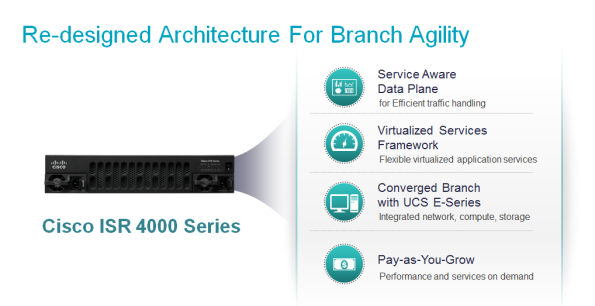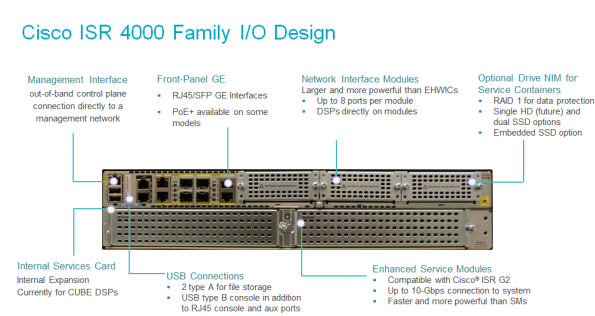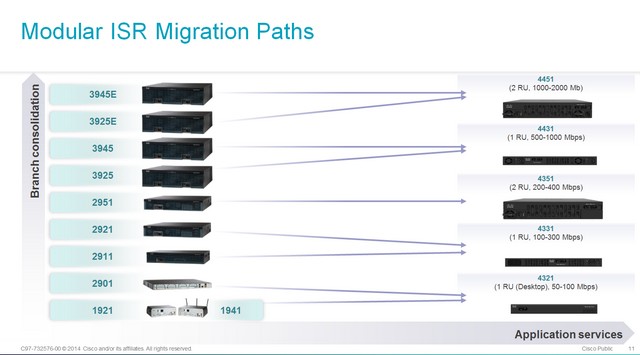
Last year, Cisco released the newest member of the ISR family, the ISR4451-X router which was the first ISR running IOS-XE. And now, in the last month of 2014, Cisco added new routers to the 4000 family, which means that the ISR G2 family will eventually go away.
The Cisco 4000 ISR family revolutionizes the delivery of application-aware services in a branch-office environment. This family provides up to 2 Gigabit performance with extensive Layer 7 services hosted internally to the branch office while maximizing operating expenses (OpEx) savings.
Cisco ISR 4000 family offers encryption acceleration, voice- and video-capable architecture, application firewall, call processing, and embedded services. In addition, the platform supports a range of wired connectivity options such as T1/E1, T3/E3, and fiber Gigabit Ethernet. This platform offers superior performance and flexibility for network deployments across large and medium-sized enterprise offices.
Cisco added four more modular platforms to the 4000 series line that scale from 50Mbps to 1Gbps. They all run the IOS XE operating system and run virtualized services in software. One great thing about the new ISR 4000 routers is that they support upgrading of the bandwidth capacity by buying a license. That means that you can keep the same router for a longer time and grow into it, rather than doing a complete replacement as your demand for bandwidth increases.
The four new routers are the 4431, 4351, 4331 and 4321.
The 4431 is 1RU and scales from 500Mbps to 1Gbps. It has four total onboard WAN or 10/100/1000 LAN ports, 2Gbytes of maximum data plane memory, 16Gbytes of maximum control plane memory, and 32Gbytes of maximum flash memory.
The 4351 scales from 200Mbps to 400Mbps. It is 2RU, with three total onboard WAN or 10/100/1000 LAN ports. It has 16Gbytes of combined data/control memory, and 16Gbytes of maximum flash memory.
The 4331 scales from 100Mbps to 300Mbps. It is 1RU, with three total onboard WAN or 10/100/1000 LAN ports. It, too, has 16Gbytes of maximum data/control and flash memory.
The 4321 scales from 50Mbps to 100Mbps. It is 1RU, with two total onboard WAN or 10/100/1000 LAN ports. It supports 8Gbytes of maximum combined data/control memory and 16Gbytes of maximum flash memory. If you need a router that does 10 Mbit/s, then you can get the 4321 and you can keep using it until you reach 100 Mbit/s.
All routers can be Application Experience (AX)-enabled with software for virtualized security, application performance and WAN optimization. These services are delivered through a Cisco UCS server blade integrated into the router, which now include one based on Intel’s E5 8 core processor.
The new features of the ISR 4000
The EHWIC of the ISR G2 has been replaced by Network Interface Modules (NIM). The NIM can also be used for service containers running applications on them. The Enhanced Service Module is compatible with the ISR G2; the NIM is not compatible with EHWIC. That means that the old ISR G2 modules will not work in the new ISR 4000 line. Some other key features of the ISR 4000 line are build-in managmenet interface, PoE+ capable ports (4451/4431 can hand out PoE+ without a module), internal service cards for DSPs, and what really caught my attention–On-line insertion and removal feature to chage cards. There is now a software shutdown command for the card that will allow you to remove it. I have not seen this demonstrated, but this is exciting!
When it comes to the models, the third number is the key to the number of slots. The 4451 has 5 total slots, the 4431 has 3 total slots, the 4421 has 2 slots, and so on. Keep that in mind when you are ordering and you will be able to know what you need quickly.
Besides the performance increases, what is nice about this new ISR 4000 line? Is that Cisco has reduced product line and reduced RU space? When looking at Modular ISR Migratiion Paths graphic below, we can see that the Cisco 1921/2901 no roll into the ISR 4321; the 2911/2921 roll into the 4331; the 2951 is similiar to the 4351; the 3925/3945 roll to the 4431, and the 3925E/3945E roll to the 4451. What is also nice, in case you have not noticed that most of the 4400 line is either 1U or 2U in space, whereas much of the old 3900 line used 3U of space. Reducing the network rack space is big in the data center where ever RU can sometimes count.
ISR G2 Module Compatibility
More tips: You also can watch the video show at YouTube: the Networking Game Changer: ISR 4451-X
More about the Cisco ISR 4451-X Router you can visit the article “Cisco ISR 4451-X, Prepared for Future Branch Network Needs”
More Cisco Router Comparison
Cisco 4451-X vs. Cisco 3945E vs. 3925E vs. Cisco 3945 vs. 3925 Router



